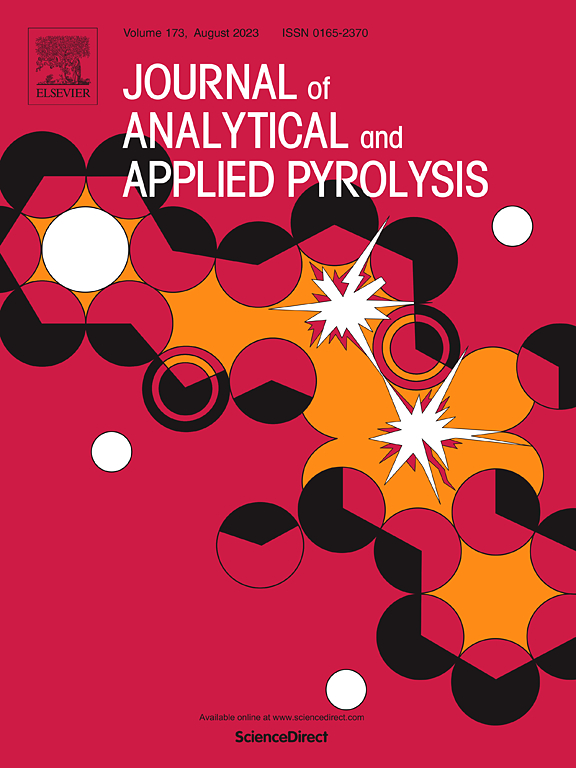Upgrading vacuum residue in a supercritical CO2 environment with polypropylene and steam: Insights into products distribution and characterization of liquid products
IF 5.8
2区 化学
Q1 CHEMISTRY, ANALYTICAL
引用次数: 0
Abstract
The pyrolysis of vacuum residue (VR) using polypropylene (PP) under supercritical carbon dioxide (scCO2) conditions represents a novel approach to converting this abundant and difficult-to-process feedstock into lighter liquid products. In this paper, a set of experiments was performed to analyze the impact of scCO2, PP and steam on the yields of pyrolysis products (i.e., liquid, gas and coke) and characteristics of the liquid fractions. The findings indicated notable improvements when scCO2 was used instead of subcritical CO2 in the pyrolysis of VR with PP. These included decreased viscosity and improved API gravity, alongside increased maltene yield and reduced coke yield. Furthermore, the inclusion of PP markedly elevated the quality of the obtained liquid, whereas steam + scCO2 primarily affected the product distribution by raising the yield of coke and gas fractions. VR pyrolysis under scCO2 conditions at 380 °C, 8 MPa, PP/VR ratio of 0.23 for 60 min in a batch system, without the use of catalyst, resulted in the highest liquid yield of 83.7 ± 1.9 wt%, and minimum coke yield of 9.8 ± 1.3 wt%. Under these conditions, the upgraded liquid consisted of 75.2 wt% light and middle distillates with boiling points below 350 °C. Additionally, the proportion of oxygenates in the pyrolysis oil reduced by 60.5 %, improving its heating value. Moreover, adding PP to the upgrading process resulted in a higher proportion of isoparaffins, cycloparaffins, and aromatics, coupled with a decrease in olefins, aligning the liquid specifications more closely with fuel standards.
用聚丙烯和蒸汽在超临界二氧化碳环境中提升真空残留物:洞察产品分布和液体产品特征
在超临界二氧化碳(scCO2)条件下使用聚丙烯(PP)对真空残渣(VR)进行热解,是将这种丰富而难以加工的原料转化为轻质液体产品的一种新方法。本文进行了一系列实验,分析了 scCO2、聚丙烯和蒸汽对热解产物(即液体、气体和焦炭)产量以及液体馏分特性的影响。研究结果表明,在 VR 与 PP 的热解过程中使用 scCO2 代替亚临界 CO2 时,效果明显改善。这包括粘度降低、API 重力提高、麦芽烯产量增加和焦炭产量减少。此外,聚丙烯的加入明显提高了所得液体的质量,而蒸汽+scCO2 则主要通过提高焦炭和气体馏分的产量来影响产品的分布。在 380 °C、8 兆帕、PP/VR 比率为 0.23 的 scCO2 条件下,在间歇系统中进行 60 分钟的 VR 热解,在不使用催化剂的情况下,液体产率最高,为 83.7 ± 1.9 wt%,焦炭产率最低,为 9.8 ± 1.3 wt%。在这些条件下,升级后的液体由 75.2 wt% 的轻质和中质馏分组成,沸点低于 350 °C。此外,热解油中含氧化合物的比例降低了 60.5%,从而提高了其热值。此外,在提纯过程中添加聚丙烯可提高异构烷烃、环烷烃和芳烃的比例,同时降低烯烃的比例,使液体规格更符合燃料标准。
本文章由计算机程序翻译,如有差异,请以英文原文为准。
求助全文
约1分钟内获得全文
求助全文
来源期刊
CiteScore
9.10
自引率
11.70%
发文量
340
审稿时长
44 days
期刊介绍:
The Journal of Analytical and Applied Pyrolysis (JAAP) is devoted to the publication of papers dealing with innovative applications of pyrolysis processes, the characterization of products related to pyrolysis reactions, and investigations of reaction mechanism. To be considered by JAAP, a manuscript should present significant progress in these topics. The novelty must be satisfactorily argued in the cover letter. A manuscript with a cover letter to the editor not addressing the novelty is likely to be rejected without review.

 求助内容:
求助内容: 应助结果提醒方式:
应助结果提醒方式:


